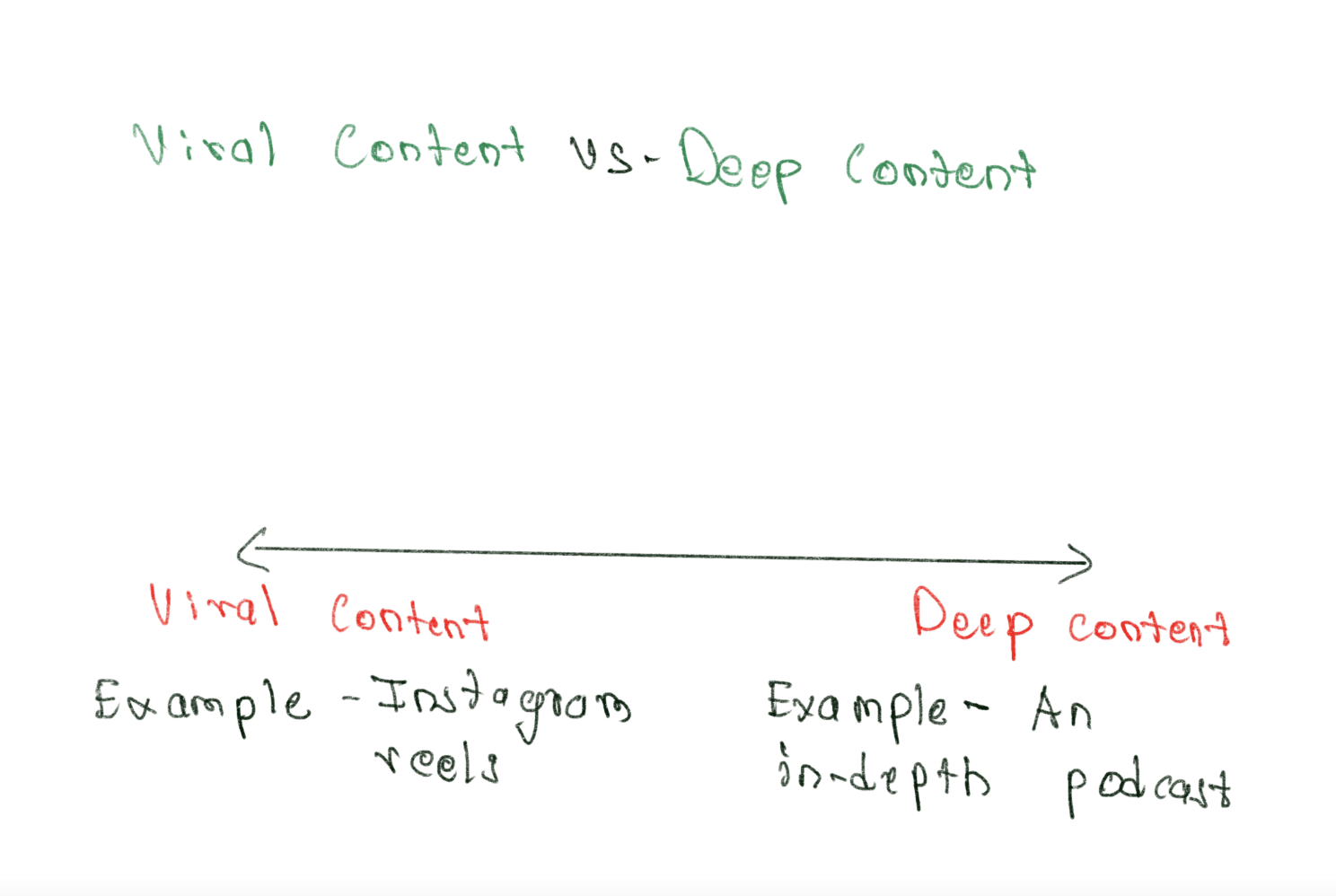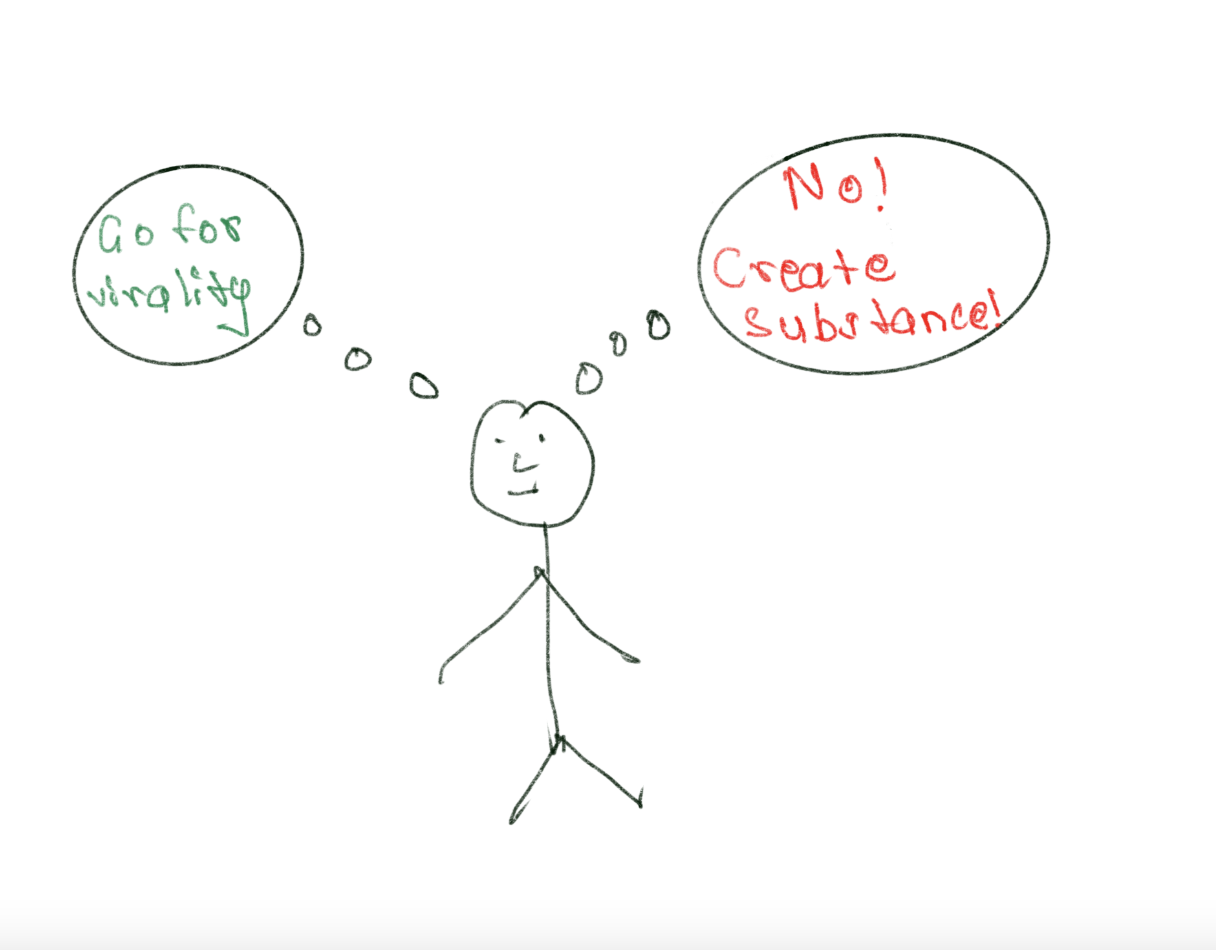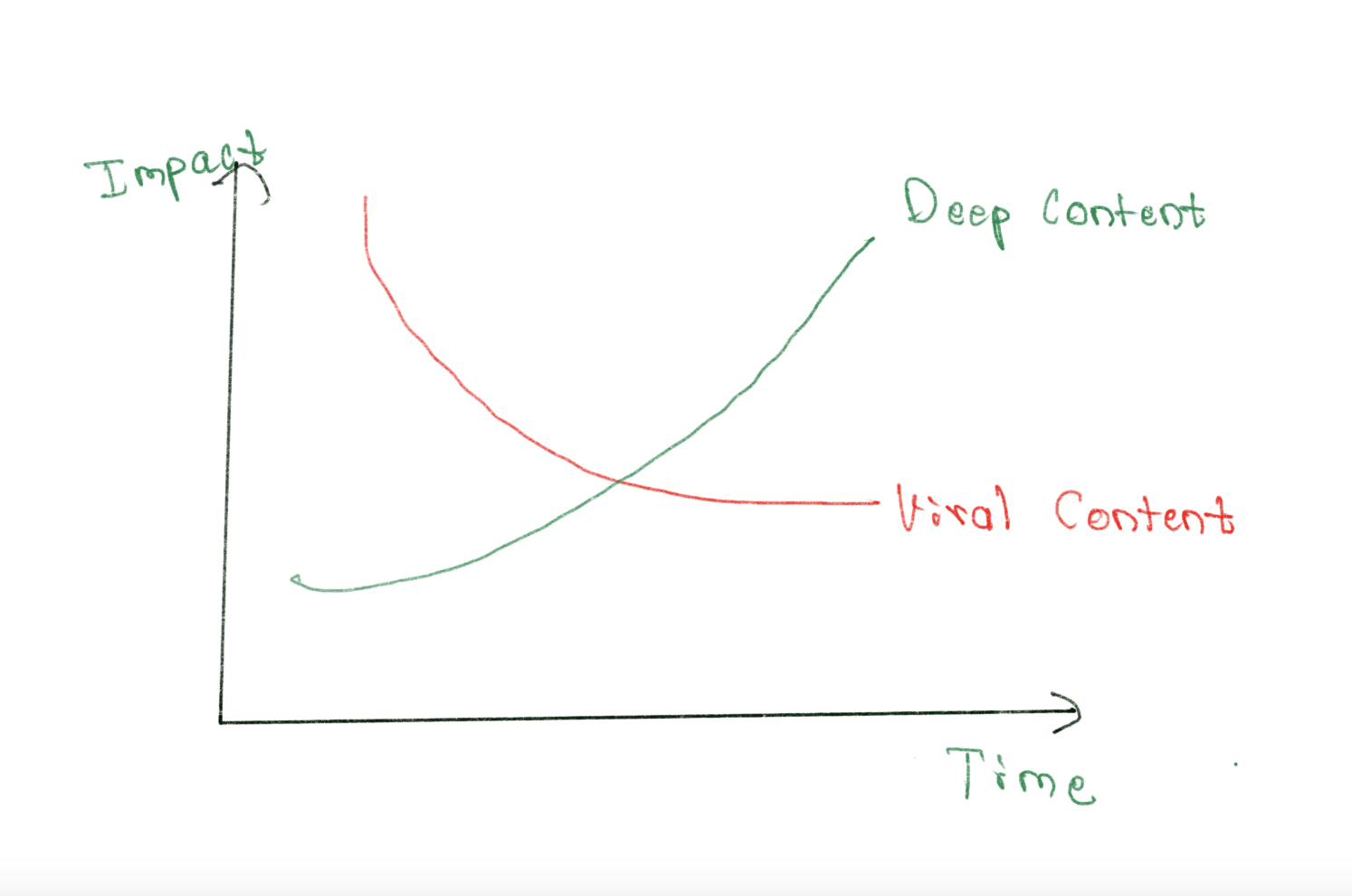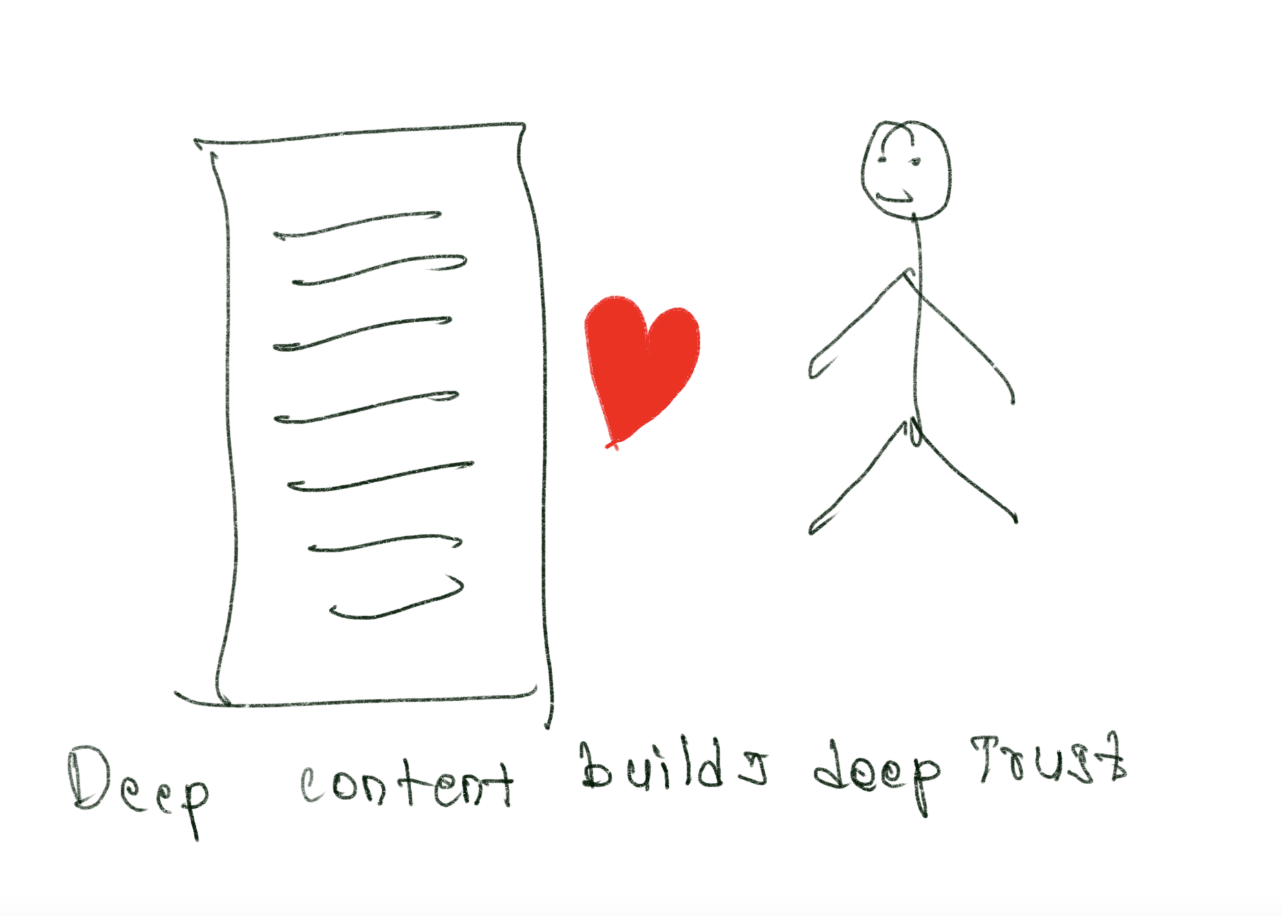When I sit down to write, a great battle takes place in my mind. There are swords, bows, cannons… and also pistols and nukes. I can feel my brain cells dying. There is chaos, confusion, and frustration. And strangely enough, I am not fighting anyone but myself. The battle is Me vs. Me.
Should I optimize my content for Virality?
OR
Should I create Deep Content?
Viral Content vs. Deep Content?
Viral content is optimized for getting noticed quickly and spreading rapidly. It’s easy to consume, provides a simplistic view of the world, and refuses to go into the nuances. It’s usually a small byte of information – a quick how-to tip or a hyper-tactical post.
Viral content is mostly found on social media but can also be found as long-form content.
Buzzfeed, for example, has a blog that is purely optimized for attention. The content is controversial, doesn’t quite offer anything insightful, and is created to appeal to the masses.
It’s not just Buzzfeed though
Even Creators and Experts (Doctors, Therapists, Environmentalists, Marketers, etc.) indulge in creating ‘Viral Content.’ A stereotypical representation of this kind of content is ‘dancing reels’ that are popular on Instagram.
Viral content lacks substance
It doesnt change the reader. But ‘Deep Content’ does. While Viral Content provides a simplistic view of the world, Deep Content covers all the nuances. It goes deep into a topic… and, most importantly, brings about a deep transformation within the audience.
Huberman Lab
One of the best examples of Deep Content is ‘Huberman Lab,’ a podcast/YouTube channel by Andrew Huberman, a neuroscientist and a Professor at Standford University. On average, his podcasts and videos are 2 hours long and yet are consumed by millions of people.
Is Deep Content better than Viral Content?
None is better. Or worse. Both approaches have their merits and drawbacks.
It’s natural to be inclined toward Viral Content. You want your content to reach the maximum number of people. Nothing wrong with it. Especially considering the efforts you put in while creating content.
But then, where do you draw the line?
What if we take this to the extreme? What if we get so invested in gathering attention that we lose sight of the transformation we seek to make? What stops us from becoming a Tik-Tok influencer who keeps on making dancing reels?
Hmmm.., so it looks like we are in a dilemma. I like to call this Viral Content vs. Deep Content spectrum.

How do we navigate through this?
The nuances are many, so perhaps you and I need to go on a journey and study them. So let’s grab that magnifying glass and start our investigation.

- What is your relationship with time?
Probably the most important factor that influences this decision is – time. If you are just starting and dreaming of having 253 likes on your Linkedin post tomorrow, you probably need to go for Viral Content. Reason? You are clearly looking for quick results, and Deep Content won’t get that for you.
Not optimized for discoverability
As Deep Content covers all nuances, It’s usually not a quick “How-to” post, and a set of bullet points cannot represent it. The very intention of Deep Content is to share detailed and nuanced learnings with the audience.
Naturally, this depth makes this content dense and also long. For Deep Content, it’s not unlikely for a podcast episode to be of 2 hours and a blog article to have 2000 words. Such dense content takes time to get noticed. Months. Years.

- How many people do you want to influence?
Does your business model depend on the number of clicks and website visitors, leaving you no choice but to go after the numbers? (Example – Buzzfeed). Or can your business thrive with just 1000 people (or even 100 people to begin with) who trust you and buy from you?
On the spectrum of “I am a Kardashian” to “I just want 1000 true fans”, where do you lie?
But what about Huberman?
Didn’t I just say millions of people view Andrew Huberman’s content? Isn’t this an exception? How is Deep Content behaving like Viral Content?
Time. That’s the answer. Andrew Huberman must have had to do this for years before his content clocked millions of views. If you and I keep investing in Deep Content for a substantial amount of time, it might eventually become popular among a larger group, thus garnering more views.
And now, coming to the last point that you need to consider…
- The depth to which you want to influence them
If you want to sell me a water bottle when I am thirsty, you don’t need to convince me. You surely wouldn’t need to write a blog about it or create a podcast informing me about the benefits of your product. But most of us are not selling water bottles. We are selling information products, online courses, or services.
High-consideration products need high trust
In such cases, there is a substantial belief shift that we need to create within our audience. This includes educating and convincing them with social proof, our big idea… and so much more!
This education is not possible in a shallow setting. Viral content is incapable of selling me a 1000-dollar course on copywriting. It just can’t.
Viral content, however, can get likes and comments, and if you are selling a product with low resistance, it might just work. However, in the long run, considering the noise, this approach is questionable.

How Louis Grenier built the ‘Everyone Hates Marketers’ podcast
If you hack into my phone and snoop around in my Spotify account, you will find multiple episodes from the ‘Everyone Hates Marketers’ podcast. Safe to say that it’s my favorite Marketing podcast. Unlike other podcasts, Louis does something very interesting…
Most podcasts invite a guest, spend 20 minutes introducing the guest and discuss multiple topics in one episode, thus creating different threads without going deep into a singular topic. To put it bluntly, the podcast episode goes all over the place.
Not with Louis though
Louis wanted to change this. In every episode, Louis challenges his guests and puts them on a spot. The goal of every episode is to go deep into a single topic. If today’s agenda is “Content Marketing,” you wouldn’t find any questions outside that.
Was this podcast optimized for discoverability? Hell no! Louis didn’t do social media, paid ads… nothing.
But is there depth? Yes. Lot of depth.
He relentlessly prioritized depth over virality. Today, Louis Grenier now runs a successful business.
But there’s something missing
Even after considering all these nuances, there is still a big missing piece. YOU. Which approach will suit YOU? YOU are an individual with desires and preferences. So how can you make this decision?
I hate competing
If you have known me for a while, you know that if you put together a wrestling match (or a chess match), I would much rather prefer sitting out. I don’t subscribe to the idea of a zero-sum game. I much rather prefer a game where both players are winning.
Viral Content is based on a zero-sum game!
When creating Viral Content, we are trying to beat the noise by shouting louder. By adding more noise. Just to get noticed. That doesn’t sit well with me. And so, you probably wouldn’t see me dancing on Instagram anytime soon.
Aggressive hooks
Another reason I would probably want to stay away from Viral Content is that I am personally uncomfortable with aggressive hooks. I cringe at the thought of writing – “99% of businesses fail because they don’t know this growth hack”.
Don’t get me wrong. Not all hooks have to be this aggressive. There are examples of people who do give some substance through their social media… but I would still prefer building my audience through a blog, podcast, or YouTube channel.
I judge viral content creators
Joke. I don’t. If ‘competition’ floats your boat, go for it. Just know who you are and take the leap. So the question is – “What kind of a game do YOU want to play?”
Because the enemy is inaction. Don’t get caught up in the battle within your mind. It doesn’t take you anywhere. Whichever path you choose, the key is to get started.
